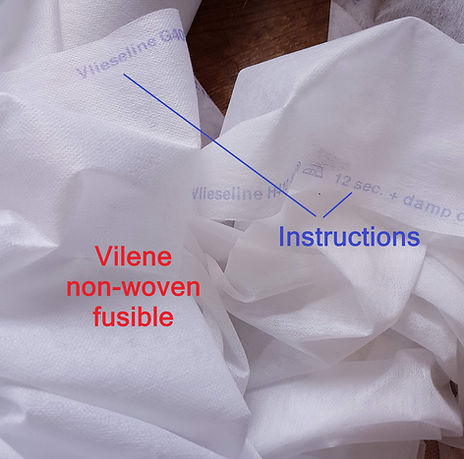
Know Your Interfacings
Most of this information is from an articles I wrote for @sewover50 a wonderful community on Instagram dedicated to making the over 50s more visible and to celebrate their love of sewing.
When someone asked if they could leave the interfacing out of a shirt collar as the one they'd just made was too stiff I said I felt she'd be disappointed if she left it out & it might be better using a lighter weight, softer interfacing.
Interfacing is a layer of fabric that goes between two layers of fashion fabric to add strength, support, stability & helps to stop edges from stretching. Interfacing is available by the metre, however its fine to use cotton poplin or another layer of your fashion fabric( that's what makers would have done before commercial interfacing was created).
There's different makes of interfacing, many without a brand name and the quality varies significantly. You need to choose one that adds the qualities you want without significantly changing the characteristics of your fashion fabric. It's worth keeping off cuts of interfacing to experiment fusing them to your fabric before you start making up to be sure it's the best one for the job.
You should use a weight of interfacing similar to your fabric
There's a wealth of amazing information on the Vlieseline website.
The following quick reference chart is reproduced courtesy of Burda Style.
Interfacing falls into different groups:
-
Woven, non woven or knitted
-
Fusible or sew-in
-
Stretch, non-stretch
-
Weight/thickness, light, medium or firm
-
Colour, white or charcoal.

Non woven is a web of fibres bonded together, so doesn't have a grainline, which means pieces can usually be cut in any direction which is less wasteful. There are some that need to be cut so they stretch in the same direction as your fabric.
Fusible interfacing is popular for home sewing as it has heat activated glue on one side that sticks it permanently to the fabric.
Sew-in interfacing will give a softer finish as it adds support and structure without changing the feel of the garment fabric. It's perfect for fabrics that can't take the heat needed for pressing.

Knitted interfacing is less common than woven or non woven and is used with knitted fabrics as it has some in built stretch, but it won't stretch as much as some fabrics.

For most dressmaking projects I keep Vlieseline H180 soft/lightweight and G405 soft/Medium in stock. Both have a small amount of stretch across the width and give a soft finish. Depending on where the interfacing will be used I place the pattern pieces with the grainline either horizontally or vertically.

Woven cotton interfacing can be fusible or sew-in. It has a selvedge so pattern pieces need to be cut on the grain and will have movement along the bias. Sew-in adds support whilst not changing the hand of the fabric.
It's good for woven fabrics where you want to use the fabric's bias to give shape, eg a soft roll on a collar or lapel.
I do like woven fusible in different weights for men's shirts. Firm ones for the collar and very lightweight for the button stand.

Silk organza is a lovely, but more expensive alternative when working with shear fabrics. It's lustrous finish allows the beauty of fine fabrics to flourish, whilst adding support. It's a woven fabric that needs cutting on grain.
It makes a perfect underlining to give body to the main fabric stopping fabrics like dupion from creasing.
Don't substitute synthetic organza as it can't take a hot iron and will soften when washed.
It also makes a brilliant press cloth, you can see through it for accuracey and it'll last a long time.

Tailoring canvas is available in may different types, weghts and thicknesses. Most are cotton, some contain horsehair for added structure.
Most can't be washed and need preshrinking by soaking in cold water, rolling in a towel to squeeze out the water and hanging to dry.
You can buy fusible tailoring canvas, often used in speed tailoring. The type and quality does vary from differnt suppliers.
I buy my tailoring supplies from Kenton Trimmings www.kentontrimmings.co.uk/shop
Tips on Using Interfacing
Whichever type of interafacing you use it's best to trim it away from the seam allowances to reduce bulk. At corner like cuffs and collar points trim the corner off so the last machine stitch only goes through your fashion fabric.
On soft, delicate fabrics I some time interface both layers of a collar with a lightweight interfacing as it stops the under collar from drooping. I even use more than one layer to get the finish I'm looking for eg to give a crisp collar at the front of a man's shirt I add an extra layer about 10cm long.
I don't think there's a definitive answer to whether you use a dry iron or damp press cloth, pressing or gliding or how long for. Each brand is different and the instructions vary depending on the specific interfacing you're using, even from the same brand. Vlieseline print the instruction along one edge of their interfacings.
